Airmails of the United States
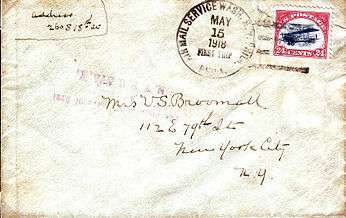
Airmails of the United States or U.S. Air Mail relates to the servicing of flown mails by the U.S. postal system within the United States, its possessions, and/or territories, marked as "Via Air Mail" (or equivalent), appropriately franked, and afforded any then existing class or sub-class of U.S. Air Mail service.
After an intermittent series of government sponsored experimental flights between 1911 and 1918, domestic U.S. Air Mail was formally established as a new class of service by the United States Post Office Department on May 15, 1918, with the inauguration of the Washington-Philadelphia-New York route for which the first of special Air Mail stamps were issued.
The exclusive transportation of flown mails by government operated aircraft came to an end in 1926 under the provisions of the "Kelly Act"[1] which required the USPOD to transition to contracting with commercial air carriers to fly them over Contract Air Mail (CAM) routes to be established by the Department, although during the first half of 1934 the U.S. Army Air Forces temporarily took over the routes — with disastrous results — when all CAM contracts were summarily cancelled by President Franklin D. Roosevelt owing to the Air Mail Scandal. Domestic air mail became obsolete in 1975, and international air mail in 1995, as distinct extra fee services when the USPS began transporting all First Class long distance intercity mail by air on a routine basis.
Experimental airmails
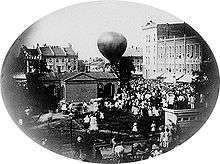
During the first aerial flight in North America by balloon on January 9, 1793, from Philadelphia to Deptford, New Jersey, Jean-Pierre Blanchard carried a personal letter from George Washington to be delivered to the owner of whatever property Blanchard happened to land on, making the flight the first delivery of air mail in the United States.[2][3]
John Wise piloted an unofficial balloon post flight that took place on July 17, 1859, from St. Louis, United States, to Henderson, New York, a distance of 1,290 km[4] on which he carried a mailbag entrusted to him by the American Express Company.[5] One month later, on August 17, Wise flew from Lafayette, Indiana, to Crawfordsville, Indiana, and carried 123 letters and 23 circulars on board that had been collected by the postmaster Thomas Wood and endorsed "PREPAID" but only one of these historic postal covers was discovered in 1957.[6] In 1959 the United States Postal Service issued a 7 cent stamp (C-54) commemorating Wise's flight in the Jupiter.[7] Balloon mail was also carried on an 1877 flight in Nashville, Tennessee.
USPOD sponsored experiments
The first official experiment at flying Air Mail to be made under the aegis of the United States Post Office Department took place on September 23, 1911, on the first day of an International Air Meet sponsored by The Nassau Aviation Corporation of Long Island, when pilot Earle L. Ovington flew 640 letters and 1,280 postcards from the Aero Club of New York's airfield located on Nassau Boulevard near Stratford School in Garden City (Long Island), New York, to the nearby Mineola Post Office in Mineola, located less than six miles away. After being duly sworn in by U.S. Postmaster General Frank Hitchcock as the first U.S. Air Mail pilot in history, Ovington took off in his own American-made Bleriot Queen tractor-type monoplane, Dragonfly, at 5:26 PM and dropped the bag of mail over Mineola six minutes later from an altitude of 500 feet. Unfortunately the bag broke when it hit the ground, but all of the mail was eventually recovered and forwarded by regular channels with the cancellation reading "AEROPLANE STATION No.1 - GARDEN CITY ESTATES, N.Y."[8][9]
Scheduled Air Mails
U.S. Government flown Air Mail

The first scheduled U.S. Air Mail service began on May 15, 1918, using six converted United States Army Air Service Curtiss JN-4HM "Jenny" biplanes flown by Army pilots under the command of Major Reuben H. Fleet and operating on a route between Washington, D.C. (Washington Polo Grounds) and New York City (Belmont Park) with an intermediate stop in Philadelphia (Bustleton Field). Among those who were on hand for the departure of the first flight from Washington, D.C., were President Woodrow Wilson, U.S. Postmaster General Albert S. Burleson, and Assistant Secretary of the Navy Franklin D. Roosevelt. Army 2nd Lt. George L. Boyle was selected to pilot aircraft #38262 on the first northbound flight which, unfortunately, turned out to be a somewhat less than successful initial venture.
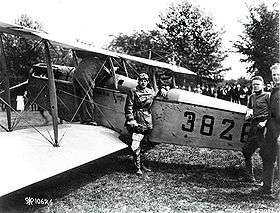
Almost immediately after taking off at 11:47AM, Boyle became disoriented and started flying South when he followed the wrong set of railroad tracks out of the city. Realizing that he was lost, Boyle attempted to find out where he was by making an unscheduled landing just 18 minutes later at 12:05PM in Waldorf, Maryland, about 25 miles south of the city. Unfortunately, however, he broke the prop on his airplane when he made a hard landing, so the 140 pounds of mail he was carrying had to be trucked back to Washington.
However aviators 1st Lt. Torrey H. Webb and 2nd Lt. James C. Edgerton completed the scheduled southbound relay with 144 pounds of mail, and Edgerton then flew Boyle's mail to Philadelphia the following day.[10] The site of the first continuously scheduled air mail service is marked by a plaque in West Potomac Park in Washington, D.C.. The route was extended to Boston three weeks later on June 4.
After four months of the mail being flown by the Army, all flight operations were taken over by the USPOD's Aerial Mail Service on August 12, 1918, using a fleet of six purpose built JR-1B mail biplanes designed and constructed by the Standard Aero Corporation of Elizabeth, New Jersey, and flown by civilian pilots hired by the Post Office Department. After a number of "pathfinder" flights made in September, November, and early December, the first flight providing scheduled east-west service between New York and Chicago occurred on December 17, 1918.[11]
Air Mail franking


The original Air Mail letter rate per ounce between any two points on the route when service began was 24 cents per ounce for which the first special purpose U.S. Air Mail stamp (C-3) was issued on May 13, 1918. The red and blue stamp's vignette depicted Army JN-4 #38262, the aircraft that made the first Air Mail flight from Washington two days later, and the 24 cent fee it represented was apportioned at two cents for postage, 12 cents for air service, and 10 cents for Special Delivery. On July 15 the rate was dropped to 16 cents for the first ounce and 6 cents for each additional ounce, and on December 15 the rate was dropped again to 6 cents per ounce when Special Delivery was made optional. Additional monochromatic stamps of similar design to C-3 were also issued contemporaneously with these rate changes in 16 cent (green) and 6 cent (orange) denominations.[12] Although these extra fee stamps were issued for use on mails to be serviced by air, the legend "AIR MAIL" did not appear on any USPOD stamp until eight years later when the 10-cent C-7 rectangular was issued on February 13, 1926, two days before the first ever mail flight under contract with a commercial carrier was made on February 15, an eastbound trip between Detroit and Cleveland over CAM Route 7.
Transcontinental Air Mail
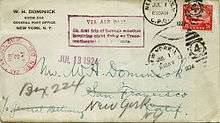
Scheduled Transcontinental Air Mail service flown between New York (Hazelhurst Field, L.I.) and San Francisco (Marina Field [13]) began on September 8, 1920, over a route laid out in July and August by Eddie Rickenbacker and Bert Acosta who had helped pilot the first experimental through flight carrying about 100 letters which landed at Durant Field located at 82nd Ave and E. 14th St. in East Oakland. The transcontinental mails were originally flown only during daylight hours while being entrained at night, although on February 22, 1921, a nighttime leg on this route (Omaha to Chicago) was flown for the first time with Jack Knight as the pilot. The first daily Transcontinental Air Mail service involving both day and night flying over the entire route was opened on July 1, 1924, which reduced the time of the trip from more than 70 hours to a schedule of 34 hours 46 minutes Westbound, and 32 hours 3 minutes Eastbound.. In addition to New York and San Francisco, the route included thirteen intermediate stops where mails were exchanged and aircrew relieved. This was accomplished at airfields located at Bellefonte (PA), Cleveland (OH), Bryan, (OH), Chicago (IL), Iowa City (IA), Omaha (NE), North Platte (NE), Cheyenne (WY), Rawlins (WY), Rock Springs (WY), Salt Lake City (UT), Elko (NV) and Reno (NV).[14]
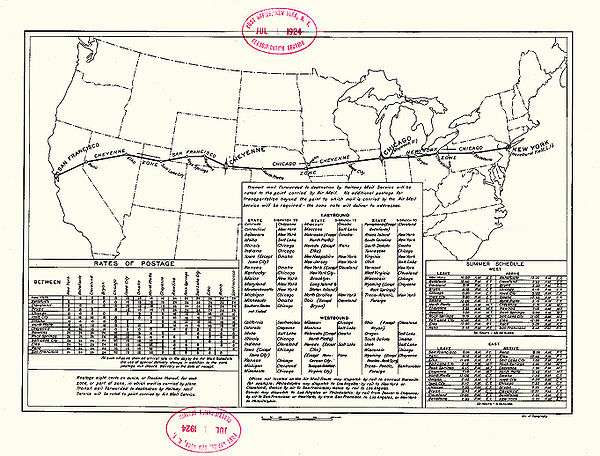
The conversion to commercially flown Air Mail

For the first eight years of the Air Mail service (May, 1918 to February, 1926), all mails were flown entirely in U.S. Government owned and operated airplanes. Dean Smith was one of those that helped instigate the pioneer air mail services and was the first to fly mail by night. On February 2, 1925, however, the Congress mandated that this would change with the passage of HR 7064 entitled "An Act to encourage commercial aviation and to authorize the Postmaster General to contract for Air Mail Service" (45 Stat. 594 (1925); P.L. 359, 68th Cong.). Better known as "The Kelly Act," it directed the U.S. Post Office Department to contract with commercial air carriers to survey, establish, and operate service over a variety of designated new routes many of which connected with the already existing Government operated Transcontinental Air Mail route between New York and San Francisco. Contracts based on competitive bids for the first five routes were awarded in October 1925, with operators originally to be compensated "at a rate not to exceed four-fifths of the revenue derived from the Air Mail." (This was changed on July 1, 1926, to a rate based on the total weight of the mails carried on each flight.) As of September 1, 1927, all U.S. Air Mail routes (including the previously Government operated Transcontinental Route) were being flown under contract by commercial carriers.[15]
Beginning Contract Air Mail (CAM) service
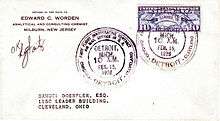
The first two commercial Contract Air Mail (CAM) routes to begin operation in the United States were CAM-6 between Detroit (Dearborn) and Cleveland and CAM-7 between Detroit (Dearborn) and Chicago which were simultaneously inaugurated on February 15, 1926. The contractor for both routes was the Ford Motor Company, operating as Ford Air Transport, using a fleet of six Ford built Stout 2-AT aircraft. Lawrence G. Fritz, later the Vice President for Operations for TWA, was the pilot of the first flight to take off with mail from Ford Airport at Dearborn, on the CAM-6 eastbound leg to Cleveland.[16][17]

On March 19, 1976, the USPS issued a 13-cent First Class commemorative Postage Stamp (Scott #1684) honoring the 50th anniversary of U.S. commercial aviation launched with Contract Air Mail service over these two routes as well as on CAM-5 which was inaugurated next on April 6, 1926, over the 487-mile route between Pasco, Washington, and Elko, Nevada, with an intermediate stop in Boise, Idaho.
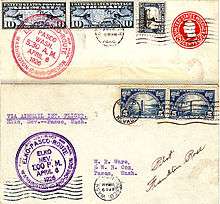
Operated by Varney Air Lines (which later became part of United Airlines), the first Eastbound flight over CAM-5 was made successfully using a Laird Swallow biplane piloted by Leon D. Cuddeback. The first Westbound flight that afternoon was much less successful, however, as it was forced 75-miles off course by a storm en route from Elko to Boise before making a forced landing near Jordan Valley, Oregon. The plane and pilot Franklin Rose remained missing for two days until Rose managed to reach a telephone on April 8 after carrying the 98 pounds of mail for many miles on foot and on a horse borrowed from a farmer. The Westbound flown mail finally arrived at the Post Office in Pasco late in the morning of April 9, three days after leaving Elko.[18][19][20]

On April 15, 1926, the third route to open (CAM-2) began operation with pilot Charles A. Lindbergh at the controls on the first flight. In October 1925, Lindbergh was hired by the Robertson Aircraft Corporation in St. Louis, Missouri, (where he had been working as a flight instructor) to first lay out, and then serve as chief pilot for the newly designated 278-mile CAM-2 to provide service between St. Louis and Chicago (Maywood Field) with two intermediate stops in Springfield and Peoria, Illinois. Operating from Robertson's home base at the Lambert-St. Louis Flying Field in Anglum, Missouri, Lindbergh and three other RAC pilots he selected (Philip R. Love, Thomas P. Nelson and Harlan A. "Bud" Gurney) flew the mail over CAM-2 in a fleet of four modified war surplus de Havilland DH-4 biplanes.[21][22] A little more than a year later Lindbergh was catapulted from being an otherwise obscure 25-year-old Air Mail pilot to virtual instantaneous world fame when he successfully piloted the Ryan NYP single engine monoplane Spirit of St. Louis on the first non-stop flight from New York to Paris in May, 1927.
Elrey Jeppesen, an airmail pilot, began to keep a notebook in 1930 filled with airfield charts, fields where he could land in an emergency, and instructions on how to land safely. Jeppesen also researched and included information about telephone or railroad service near these landing fields. Jeppesen provided copies of his notebook to fellow pilots - not, he said, to make money, but "to stay alive." In a decade of service after the conclusion of the war, fatality rates improved from a rough average of 1 per 100,000 miles flown, to 1 per 1.4 million miles flown in 1927.[23]
A total of 34 Contract Air Mail routes would eventually be established in the US between February 15, 1926, and October 25, 1930, however with the so-called "Air Mail Scandal" in 1934 the USPOD cancelled all the contracts on February 9, 1934, which resulted in the suspension of commercial CAM service effective February 19, 1934.[24] Air Mail was flown exclusively by the U.S. Army (as the "Army Air Corps Mail Operation") from February 19 to May 8, 1934, when new temporary contracts with private carriers were put into effect. During this period there were a total of 66 accidents resulting in the deaths of 12 Army pilots including two who were killed on the last AACMO flight on June 6, 1934.

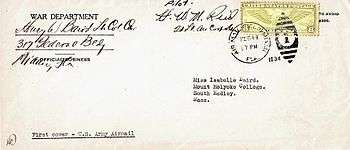

The end of domestic U.S. Air Mail as a distinct service
Air Mail as a distinct service was effectively ended within the United States on October 10, 1975, however, when all domestic intercity First Class mails began to be transported by air whenever practical and/or expeditious at the normal First Class rate. Domestic Air Mail as a separate class of service (and its rate structure) was formally eliminated by the successor to the Post Office Department, the United States Postal Service (USPS) on May 1, 1977.[25]
When the USPS began to service all international First Class mails by air without additional charge in 1995 and simultaneously eliminated Surface (or "Sea") service which provided transportation by ship, it also announced that the words "Air Mail" would no longer appear on any U.S. postage stamps.[26] While the USPS no longer offers traditional letter Air Mail, it does provide various classes of "premium" domestic and international business, priority, and express Air Mail services with guaranteed delivery times at much higher rates.[27]
In June 2006 the USPS formally trademarked Air Mail (two words with capital first letters) along with Pony Express.[28]
Foreign U.S. Air Mail
First experimental foreign Air Mail flight
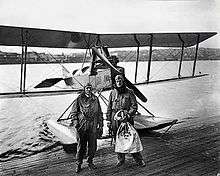
The first experimental foreign Air Mail flight from the U.S. was made by Eddie Hubbard and William E. Boeing while on a survey flight to Vancouver, British Columbia, on March 3, 1919.[29] On board with them was a mail bag containing 60 letters, making this the first international U.S.Air Mail flight. Their aircraft was a modified World War I Boeing Model C trainer which had a cruising speed of 65 mph.[30] Hubbard later flew the first international contract mail route, from Seattle to Victoria, British Columbia, which began on October 15, 1920. The route (FAM 2) was created to connect with steamships going to Asia.
Boeing started up an airplane manufacturing business which sold 50 aircraft to the U.S. Navy.[31] At the end of war Boeing began to concentrate on commercial aircraft, secured contracts to supply airmail service and built a successful airmail operation. His airmail business was in the middle of the Air Mail scandal of the 1930s. In 1934, the United States government accused Boeing of monopolistic practices. The Air Mail Act of 1934 ordered him to break up his company into three separate entities: United Aircraft Corporation, Boeing Airplane Company, and United Air Lines. Thomas Braniff led the fight by independent airlines to break the power of the airline holding companies that dominated air transportation in the 1930s.[32]
US Army Air Mail pilots (1918)

- 2nd Lt. James Clark Edgerton (1896-1973) As a young Army 2nd Lieutenant fresh out of flight school, Edgerton flew the Philadelphia to Washington, DC, leg on the first day of scheduled Air Mail service in the United States on May 15, 1918. Over the next five months as an Army Air Mail pilot Edgerton flew 52 trips over a total of 7,155 miles, spending 107 hours in the air and making only one forced landing.[33] When the Post Office Department took over flying operations of the Air Mail Service in October, 1918, Edgerton stayed on and eventually became Superintendent of Flying Operations. Later he organized and became Superintendent of the Radio Service of the Post Office Department establishing its first aeronautical radio stations, helped to organize a civilian pilot-training program, and as a Colonel during World War II served as executive officer for air operations of the War Department.[34]
- Maj. Reuben Hollis Fleet (1887-1975). He was born on March 6, 1887 in Montesano, Washington. He learned to fly at the Army Aviation school in San Diego, California. By 1918 he was a Major and was supervising pilot training. He then was assigned the task of creating the logistics for regularly scheduled airmail service for three cities. Service began on May 15, 1918. He left the Air Service and in 1923 formed Consolidated Aircraft Corporation. He retired in 1949 and died on October 29, 1975 at age 88.[35]
- 2nd Lt. George Leroy Boyle Also just out of flight school, Boyle flew the first northbound Washington, DC to Philadelphia leg on May 15, 1918 but got lost and made a forced landing near Waldorf, Maryland just 18 minutes after takeoff. After a second failed attempt on May 16 to again fly the mail from Washington to Philadelphia which ended in a crash landing on a Philadelphia golf course, Lt. Boyle was summarily dismissed from the Air Mail service by Maj. Fleet.
See also
| Wikimedia Commons has media related to United States Air Mail. |
Notes
- ↑ Airmail: The Air Mail Act of 1925 Through 1929 U.S. Centennial of Flight Commission
- ↑ "Jean Pierre Blanchard: Made First U.S. Aerial Voyage in 1793". HistoryNet.com. Archived from the original on 4 July 2008. Retrieved 2008-07-16.
- ↑ "Jean Pierre François Blanchard". U.S. Centennial of Flight Commission. Archived from the original on 25 June 2008. Retrieved 2008-07-16.
- ↑ Smith (1942), p. 51.
- ↑ Allaz (2005), p. 14.
- ↑ Mackay (1971), pp. 17–18.
- ↑ "'Stamps Take Flight' exhibit from Postmaster General's Collection showcases world's rarest 'uncollectibles' at National Postal Museum". Press release. USPS. 2005-04-06. Archived from the original on 18 June 2008. Retrieved 2008-07-04.
- ↑ FLIGHT INTO HISTORY: EARLE OVINGTON WAS FIRST Air Mail Pioneers
- ↑ "Plane Presented to Garden City Post Office"
- ↑ "Air-Mail System Runs True to Schedule, Except for Mishap at Washington End", The Philadelphia PUBLIC-LEDGER, May 16, 1918.
- ↑ Jones, A.D. Aerial Mail Service: A Chronology of the Early United States Government Air Mail March - December, 1918. Mineola, NY: The American Air Mail Society. (1993) pp 53-113
- ↑ "Postage Stamps of the United States First Issued in 1918". 1847usa.com. Archived from the original on 2008-04-28. Retrieved 2010-03-29.
- ↑ http://www.airfields-freeman.com/CA/Airfields_CA_SanFran.htm#marina
- ↑ U.S. Centennial of Flight Commission "The Post Office Flies the Mail, 1918-1924"
- ↑ Glines, Carroll V. "The Saga of the Air Mail" (1980) Ayer Publishing. ISBN 0-405-12213-6.
- ↑ CAM Contract Air Mail First Flights CAM-6
- ↑ CAM Contract Air Mail First Flights CAM-7
- ↑ The Pasco (WA) Herald (Newspaper), Air Mail Jubilee Attracted Thousands of Visitors to Pasco April 8, 1926, p. 1.
- ↑ Oberst, Walter A. Railroads, Reclamation And the River: A History of Pasco (Pasco: Franklin County Historical Society, 1978)
- ↑ CAM Contract Air Mail First Flights CAM-5
- ↑ The St. Louis POST-DISPATCH (Newspaper) April 16, 1926, p. 1.
- ↑ CAM Contract Air Mail First Flights CAM-2
- ↑ Lieut Lesti Maitland (15 December 1928). "Making the Air Safe for Humanity". Liberty Magazine.
- ↑ CAM (Contract Air Mail) First Flights - Index
- ↑ "No. 912. U.S. Postal Service Rates for Letters and Post Cards: 1958 to 1989", Statistical Abstract of the United States: 1990, United States Bureau of the Census, p. 549, 1990
- ↑ Baadke, Michael Airmail stamps fulfill various postage rates Linn's Stamp News
- ↑ USPS Rates for Domestic and International Services
- ↑ "U.S. Postal Service Expands Licensing Program". News Release #06-043. USPS. 2006-06-20. Archived from the original on 6 July 2008. Retrieved 2008-07-18.
- ↑ The American Institute of Aeronautics and Astronautics (AIAA)/History/1919: http://www.aiaa.org/content.cfm?pageid=260&period=1910s
- ↑ Boeing History Archives:http://www.boeing.com/history/boeing/modelc.html
- ↑ Encyclopædia Britannica:http://www.britannica.com/EBchecked/topic/71236/William-E-Boeing
- ↑ Smithsonian National Air and Space Museum Archives: http://www.nasm.si.edu/exhibitions/gal102/americabyair/innovation/innovation05.cfm
- ↑ "PILOT STORIES: James C. Edgerton" Smithsonian Institution National Postal Museum
- ↑ "James Edgerton, Air Mail Pioneer: Colonel Who Flew on First Regular Route Dies at 77". New York Times Oct 30, 1973, p. 46
- ↑ "Edmund T. "Eddie" Allen". National Postal Museum. Retrieved October 23, 2012.
References
- Richard McP. Cabeen, Standard Handbook of Stamp Collecting (Collectors Club, 1979), pp. 207–221
- Allaz, Camille; Translated by John Skilbeck (2005). History of Air Cargo and Airmail from the 18th century. Christopher Foyle Publishing. p. 408. ISBN 0-9548896-0-6.
- Harmer, Cyril Henry Carrington (1984). Newfoundland Air Mails. Cinnaminson, NJ: American Air Mail Society. p. 181.
- Mackay, James A. (1971). Airmails 1870–1970. London: B. T. Batsford. p. 216. ISBN 0-7134-0380-2.
- Smith, Henry Ladd (1942). Airways: The History of Commercial Aviation in the United States. New York: Alfred A. Knopf. p. 460.
- edited by Simine Short, with Cheryl Ganz, associate editor. (1992). Via airmail : an aerophilatelic survey of events, routes, and rates. Chicago: American Air Mail Society. p. 242. ISBN 0-939429-01-2.
External links
- The short film "1ST Air Mail (1976)" is available for free download at the Internet Archive